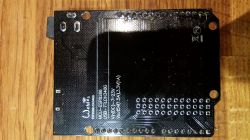I have a WeMos D1 R2 ESP8266 + 32 Mb flash WiFi RobotDyn which looks as follows.


When plugged in, the WiFi network appeared with the default name so it can be considered to be working. I bought it with the idea of uploading WLED firmware and making it into a driver for Christmas lights on WS2811 LEDs according to the kno.wled.ge/ project.
The firmware upload itself is working fine. I tried doing it on line from the install.wled.me website I also had a bin downloaded from github uploaded according to various tutorials from the site. I also tried uploading the module into flash mode by shorting D3 (GPIO0) to ground and pressing reset - then the SCK diode lights up. After flashing finished, I shorted D3 (GPIO0) to 5V and reset to make the diode go off. Unfortunately the wifi doesn't start, no default network appears so it's not possible to go to the configuration, which is done via the browser or the app. Not sure where the problem lies.
The second problem is that there is no original flash on which I could check if WiFi still works at all. The manufacturer's website does not provide anything for this model, on the internet also everything for the D1 or D1 mini version with 4 Mb of flash only available.
The creator of the whole batch states that it works on Wemos D1 mini and Wemos D1 mini pro with ESP8266 so why would it not work on my D1 R2?


When plugged in, the WiFi network appeared with the default name so it can be considered to be working. I bought it with the idea of uploading WLED firmware and making it into a driver for Christmas lights on WS2811 LEDs according to the kno.wled.ge/ project.
The firmware upload itself is working fine. I tried doing it on line from the install.wled.me website I also had a bin downloaded from github uploaded according to various tutorials from the site. I also tried uploading the module into flash mode by shorting D3 (GPIO0) to ground and pressing reset - then the SCK diode lights up. After flashing finished, I shorted D3 (GPIO0) to 5V and reset to make the diode go off. Unfortunately the wifi doesn't start, no default network appears so it's not possible to go to the configuration, which is done via the browser or the app. Not sure where the problem lies.
The second problem is that there is no original flash on which I could check if WiFi still works at all. The manufacturer's website does not provide anything for this model, on the internet also everything for the D1 or D1 mini version with 4 Mb of flash only available.
The creator of the whole batch states that it works on Wemos D1 mini and Wemos D1 mini pro with ESP8266 so why would it not work on my D1 R2?






